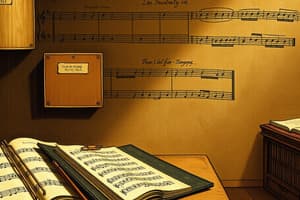Podcast
Questions and Answers
What is Tone Color?
What is Tone Color?
- Creates variety, continuity and mood (correct)
- A musical scale
- A rhythm pattern
- A specific type of melody
The rhythm of 20th-century music became regular and predictable.
The rhythm of 20th-century music became regular and predictable.
False (B)
What is Polyrhythm?
What is Polyrhythm?
A rhythm that makes use of two or more different rhythms simultaneously.
What is an Ostinato?
What is an Ostinato?
What defines a Polychord?
What defines a Polychord?
Consonant chords sound dissonant and create tension.
Consonant chords sound dissonant and create tension.
Dissonant chords add tension and anxiety to music.
Dissonant chords add tension and anxiety to music.
Who was Nikolai Rimsky-Korsakov?
Who was Nikolai Rimsky-Korsakov?
What contribution did Gustav Mahler make to music?
What contribution did Gustav Mahler make to music?
Who was Dimitri Shostakovich?
Who was Dimitri Shostakovich?
What characterizes Impressionism in music?
What characterizes Impressionism in music?
Who were the two most important Impressionistic composers?
Who were the two most important Impressionistic composers?
What is Atonality?
What is Atonality?
Who invented the 12-tone system?
Who invented the 12-tone system?
What does the 12-tone system allow in music composition?
What does the 12-tone system allow in music composition?
What is Sprechstimme?
What is Sprechstimme?
What does Neo-Classicism seek to achieve?
What does Neo-Classicism seek to achieve?
What was the slogan of Neo-Classicism?
What was the slogan of Neo-Classicism?
Who is Igor Stravinsky?
Who is Igor Stravinsky?
What was the Bay Psalm Book (1640)?
What was the Bay Psalm Book (1640)?
What were the favorite instrumental organizations in America in the 19th century?
What were the favorite instrumental organizations in America in the 19th century?
Which cities in America established symphony orchestras in the 19th century?
Which cities in America established symphony orchestras in the 19th century?
Who pioneered Nationalism in American Music?
Who pioneered Nationalism in American Music?
Who was Amy Beach?
Who was Amy Beach?
What was the musical contribution of Charles Ives?
What was the musical contribution of Charles Ives?
Who was William Grant Still?
Who was William Grant Still?
Who is Aaron Copland known for?
Who is Aaron Copland known for?
Flashcards are hidden until you start studying
Study Notes
Tone Color
- Enhances variety, continuity, and mood in music.
Rhythm of 20th Century Music
- Characterized by irregular and unpredictable patterns.
Polyrhythm
- Utilizes two or more different rhythms played simultaneously.
Ostinato
- A repeated musical phrase throughout a composition.
Polychord
- A combination of two or more different chords.
Consonant Chords
- Produce a pleasing sound, providing a sense of resolution.
Dissonant Chords
- Create tension and anxiety, needing resolution to consonant chords.
Nikolai Rimsky-Korsakov
- Russian composer, part of "The Five," known for intricate orchestrations in tone poems.
Gustav Mahler
- A late Romantic composer, professional conductor; his works gained recognition in the 1950s through Leonard Bernstein.
Dimitri Shostakovich
- Soviet composer known for Neo-Classical work, faced censorship and attempted blacklisting by Stalin.
Impressionism
- French artistic movement marked by exotic scales, unresolved dissonances, rich orchestral tone colors, and free rhythms.
Claude Debussy and Maurice Ravel
- Key composers of Impressionism, pivotal in transitioning music from Romanticism to Atonality through exotic scales and dissonance.
George Gershwin
- Notable American composer, known for blending Jazz and Classical music styles.
Expressionism
- Artistic movement focused on the artist's inner vision and intense emotions, often exploring themes of madness and death.
Atonality
- Characterized by the absence of a specific key or tonal center.
Arnold Schoenberg
- A prominent German composer of the 20th century, credited with developing the 12-tone system.
12-Tone System
- Compositional method derived from a specific ordering of the 12 chromatic tones, established by Schoenberg in the early 1920s.
Possible Tone Rows
- There are 479,001,600 arrangements for a 12-tone row; each can be transformed in 48 different ways within a composition.
Sprechstimme
- A vocal technique that merges speaking and singing, often used by Schoenberg.
Neo-Classicism
- A movement aiming to revive the musical forms and aesthetics of the Baroque and Classical periods, featuring emotional restraint and balance.
Back to Bach
- Slogan representing the Neo-Classical movement, which reacted against Romanticism and Impressionism.
Igor Stravinsky
- Russian Neo-Classical composer, celebrated for influential ballets like The Rite of Spring; known for changing, irregular meters.
Bay Psalm Book (1640)
- The first book of songs published in America.
19th Century American Instrumental Organizations
- Brass and military bands were the preferred instrumental groups.
American Cities with Symphony Orchestras
- New York, Cincinnati, Boston, and Chicago were early adopters of symphony orchestras.
Nationalism in American Music
- Prominent figures include Gottschalk and Dvořák, who influenced the movement.
Amy Beach
- The first notable female composer in American music history.
Charles Ives
- American composer known for dissonant, atonal works influenced by hymns and folk music, independent of Schoenberg's impact.
William Grant Still
- Recognized as the first major African American classical composer.
Aaron Copland
- Leading American composer, renowned for creating cowboy-themed ballets such as "Billy the Kid" and "Rodeo."
Studying That Suits You
Use AI to generate personalized quizzes and flashcards to suit your learning preferences.




